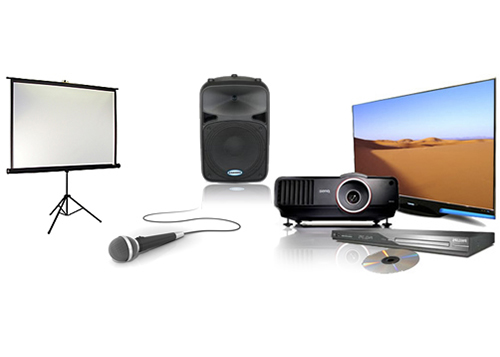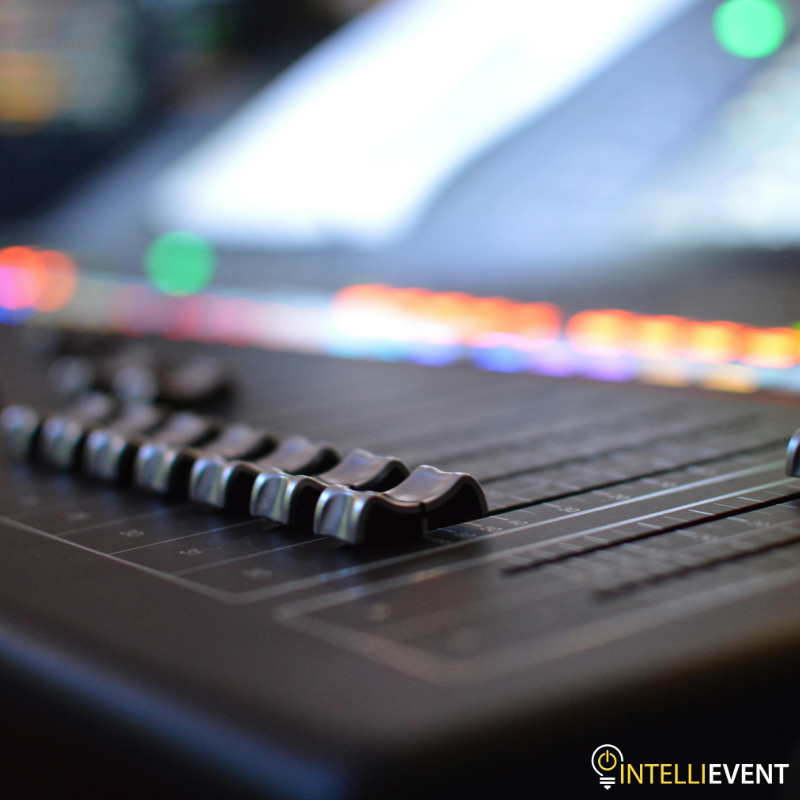Pro strategies for working with audio visual charlotte nc providers
Wiki Article
Recognizing the Addition of Audio Visual Innovation in Today's Educational Environments
The combination of audio-visual innovation in academic settings has actually changed the mentor and finding out procedure. Educators currently have accessibility to devices that deal with various learning designs, boosting pupil involvement and partnership. Nevertheless, the incorporation of these technologies presents both possibilities and obstacles. Understanding exactly how to properly carry out these tools is necessary. What strategies can teachers use to optimize the benefits of audio-visual technology in their class?The Advancement of Audio-Visual Technology in Education
As instructional demands evolved over the years, audio-visual technology went through substantial transformations that reshaped the discovering environment. Devices such as movie projectors and slide programs were the key ways of incorporating visual components into class. These very early modern technologies provided teachers with the ability to existing information dynamically, yet they were limited in ease of access and interactivity.With the introduction of videotape recorder in the 1970s, class began to integrate recorded lessons, expanding the scope of academic sources. The introduction of computers in the 1980s additional reinvented this landscape, permitting the development of multimedia discussions and interactive discovering experiences.
The increase of the net in the 1990s marked a zero hour, making it possible for real-time access to a riches of audio-visual products. Today, digital tools such as interactive whiteboards and online discovering systems proceed to boost the educational experience, fostering interaction and partnership amongst students.
Advantages of Audio-Visual Devices for Diverse Learning Styles
Audio-visual tools play an essential role in dealing with varied understanding designs by boosting aesthetic understanding and boosting acoustic engagement. By integrating pictures, videos, and noise, these modern technologies produce a more inclusive academic atmosphere. This complex technique permits educators to address the diverse preferences and requirements of students effectively.Enhancing Visual Understanding
Interaction in the knowing procedure is noticeably improved through making use of audio-visual devices, satisfying numerous discovering styles. These tools, such as video clips, infographics, and interactive discussions, offer aesthetic stimulations that help understanding and retention. Aesthetic students, particularly, benefit from the incorporation of images and animations, which can streamline intricate ideas and improve understanding. Additionally, audio-visual resources can illustrate real-world applications, making finding out more pertinent and interesting. By incorporating color, activity, and noise, instructors can produce a vibrant knowing atmosphere that records trainees' focus and fosters deeper cognitive connections. Eventually, the strategic use of audio-visual modern technology not only sustains visual discovering but likewise improves the general educational experience for varied learners.Improving Auditory Involvement
A significant benefit of incorporating audio-visual devices in education and learning is their capability to enhance auditory engagement among trainees. These tools, which incorporate multimedia presentations, podcasts, and interactive sound elements, provide to various learning styles, specifically benefiting acoustic students (audio visual charlotte nc). By incorporating sound and narrative, teachers can create immersive experiences that capture pupils' interest and reinforce understanding. This interaction is vital, as it cultivates a deeper understanding of the material and promotes retention. Furthermore, audio-visual devices can promote collaborative knowing atmospheres, encouraging trainees to take part in discussions and share their insights. Eventually, the consolidation of audio-visual innovation not just sustains auditory engagement but also enriches the overall academic experience, making finding out more vibrant and efficient for all traineesEnhancing Interaction With Interactive Discovering

Furthermore, gamification aspects, such as tests and simulations, can improve inspiration and retention, making discovering more enjoyable and reliable. These strategies not only boost cognitive interaction yet likewise satisfy varied discovering styles, making certain that all trainees can participate meaningfully. Therefore, interactive understanding atmospheres foster a sense of community and belonging, inevitably leading to enhanced scholastic outcomes. With the integration of audio aesthetic modern technology, teachers can change conventional classrooms into lively rooms where trainees prosper and proactively form their instructional trips.
Linking Concept and Experiment Multimedia Resources
Multimedia sources work as an important link between theoretical ideas and sensible application in academic setups. By enhancing engagement, promoting collective discovering experiences, and sustaining diverse discovering designs, these devices produce a more inclusive and vibrant learning setting - audio visual charlotte nc. This strategy not just cultivates deeper understanding however likewise prepares students for real-world difficulties
Enhancing Engagement Via Multimedia
Engagement in educational setups substantially enhances when trainers integrate multimedia resources right into their mentor approaches. Making use of video clips, podcasts, and interactive presentations enhances the learning experience, permitting trainees to get in touch with the product on multiple degrees. Multimedia sources deal with different discovering styles, supplying visual, acoustic, and kinesthetic stimuli that can hold students' interest better than conventional lecture methods. Additionally, these resources can streamline complicated concepts, making them more accessible and remarkable. By integrating multimedia, educators can develop a vibrant classroom setting that promotes curiosity and encourages learners. Inevitably, the critical use of audio-visual technology serves to link the gap in between academic understanding and functional application, enhancing the academic experience for check here both instructors and trainees.Promoting Collaborative Learning Experiences
Countless researches suggest that joint knowing experiences significantly improve student results when incorporated with multimedia sources. Multimedia devices help with communication amongst pupils, allowing them to participate in analytic and critical believing jointly. By making use of video clip conferencing, collaborative platforms, and interactive discussions, instructors develop environments favorable to synergy and shared knowing. These innovations make it possible for students to connect their concepts effectively and obtain prompt feedback, fostering a deeper understanding of the topic. Additionally, multimedia sources can present complex ideas in even more absorbable formats, promoting discussion and cooperation. As a result, the mix of collaborative knowing and audio-visual modern technology not only improves the academic experience yet also prepares pupils for real-world teamwork dynamics, highlighting the significance of cooperation and collective knowledge building.Sustaining Diverse Discovering Styles
While traditional mentor methods commonly deal with a minimal series of finding out choices, the assimilation of audio-visual modern technology supplies a much more comprehensive method to education. By using multimedia sources such as video clips, interactive simulations, and electronic presentations, educators can address numerous finding out styles, including aesthetic, auditory, and kinesthetic. This adaptability permits for set apart direction, enabling pupils to engage with web content in means that reverberate with their private choices. Furthermore, audio-visual devices can assist in deeper understanding by giving several representations of complicated ideas. Consequently, students who may have problem with conventional techniques can discover alternative paths to success, fostering a much more equitable discovering environment that supports scholastic accomplishment for all learners.Difficulties in Implementing Audio-Visual Innovation
Although audio-visual technology holds excellent promise for enhancing academic experiences, its implementation frequently runs into significant difficulties. One primary problem is the monetary worry connected with purchasing and maintaining such devices, which can stress budget plans, specifically in underfunded establishments. Furthermore, inadequate training for instructors can prevent efficient assimilation, leaving them ill-prepared to utilize the modern technology fully. Technical concerns, such as software program breakdowns and compatibility issues, may also interfere with lessons and irritate both instructors and pupils. Furthermore, varying levels of student accessibility to modern technology outside the class can produce disparities in discovering possibilities. The potential for over-reliance on technology may take away from important mentor methods, inevitably limiting the educational experience. Dealing with these difficulties needs an extensive strategy, consisting of appropriate funding, professional growth, and equitable access to sources, to ensure that audio-visual innovation can be leveraged efficiently in today's instructional setups.Ideal Practices for Integrating Innovation in the Classroom

In addition, fostering an interactive environment through collaborative tools urges pupil interaction and participation. Making use of diverse audio-visual sources provides to different finding out styles, suiting visual, acoustic, and kinesthetic students. Consistently examining the impact of technology on student knowing helps teachers refine their methods and adapt to changing needs. Including students in the selection of technology promotes ownership and inspiration. By sticking to these finest methods, teachers can create a dynamic class atmosphere that successfully integrates innovation and enhances the educational experience for all trainees.
The Future of Audio-Visual Technology in Education
As classrooms increasingly welcome technology, the landscape of audio-visual tools in education and learning remains to progress (audio visual charlotte nc). Future improvements are anticipated to focus on better interactivity and personalization, allowing instructors to tailor finding out experiences to private student requirements. Developments such as augmented fact (AR) and online reality (VIRTUAL REALITY) will likely offer immersive learning settings, enhancing trainee interaction and understanding
Furthermore, expert system (AI) is positioned to play a significant function in audio-visual modern technology by using real-time feedback and adaptive understanding pathways. This combination may assist educators determine and address trainee obstacles a lot more efficiently. Cloud-based systems will promote much easier accessibility to resources and cooperation among students and teachers, despite location.
In enhancement to these technical advances, professional development for instructors will be essential, ensuring they are outfitted to utilize these tools effectively. In general, the future of audio-visual modern technology in education guarantees to develop even more vibrant, comprehensive, and impactful understanding experiences.
Often Asked Concerns
Just How Can Teachers Pick the Right Audio-Visual Tools for Their Classrooms?
Choosing appropriate audio-visual devices needs teachers to examine their instructional goals, consider trainee requirements, examine readily available innovation, and look for suggestions from peers or professionals, making certain devices effectively boost understanding and involvement within their certain classroom setting.What Spending plan Considerations Are There for Executing Audio-Visual Modern Technology?
Spending plan factors to consider for executing audio-visual innovation include first acquisition expenses, maintenance expenditures, training for personnel, and possible software program licensing charges. Furthermore, long-term investment in updates and substitutes must also be factored right into financial preparation.Exist Specific Training Resources for Educators on Audio-Visual Devices?
Several establishments provide training sources for instructors on audio-visual devices, including online programs, workshops, and instructional overviews. These sources aim to improve educators' abilities and confidence in successfully integrating modern technology into their teaching techniques.How Do We Gauge the Effectiveness of Audio-Visual Modern Technology in Learning?
Determining the performance of audio-visual technology in finding out involves reviewing trainee involvement, comprehension, retention rates, and total academic performance. Studies, assessments, and empirical researches can offer beneficial insights into its effect on educational end results.What Prevail Mistaken Beliefs About Audio-Visual Technology in Education And Learning?
Common misconceptions regarding audio-visual technology in education include the belief that it ensures involvement and finding out results, in addition to the assumption that all pupils benefit equally, forgeting individual knowing choices and demands.Report this wiki page